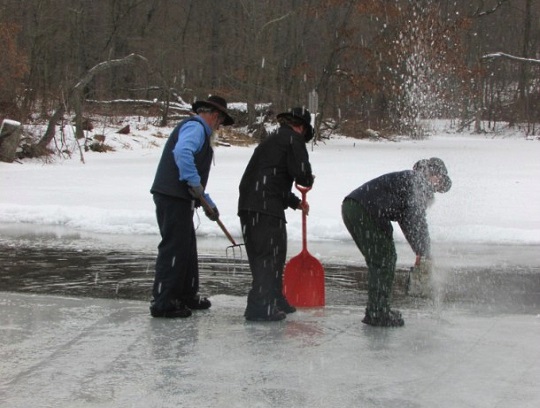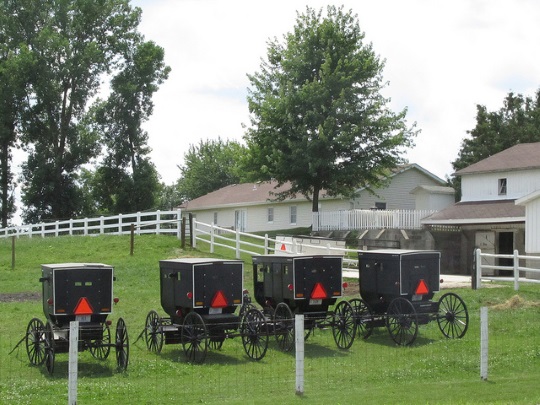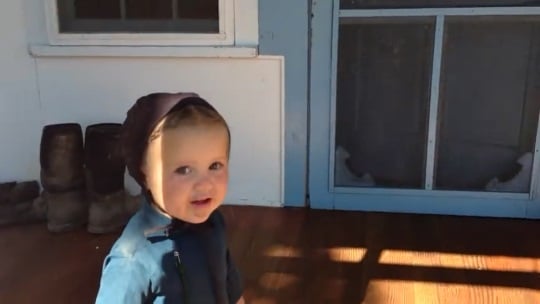Amish Gene Mutation May Extend Lifespan By 10 Years
Amish carriers of a gene mutation live about 10 years longer on average than others in their community without the mutation.
They also appear to be “completely protected from the development of diabetes”, according to the study’s lead researcher.
This story is going around the internet like gangbusters now. The discovery was made by scientists from Northwestern University:
The first genetic mutation that appears to protect against multiple aspects of biological aging in humans has been discovered in an extended family of Old Order Amish living in the vicinity of Berne, Indiana, report Northwestern Medicine scientists.
…
Indiana Amish kindred (immediate family and relatives) with the mutation live more than 10 percent longer and have 10 percent longer telomeres (a protective cap at the end of our chromosomes that is a biological marker of aging) compared to Amish kindred members who don’t have the mutation, reports the new Northwestern study.
Amish with this mutation also have significantly less diabetes and lower fasting insulin levels. A composite measure that reflects vascular age also is lower — indicative of retained flexibility in blood vessels in the carriers of the mutation — than those who don’t have the mutation, the research also found.
The researchers’ paper can be found here.
The key element here is a protein called PAI-1 (plasminogen activator inhibitor), described as part of a “molecular fingerprint” connected to aging. Amish with the mutation have about half the amount of PAI-1 as those without.
There are often claims made about Amish having various sorts of built-in health advantages, some of which are dubious. But this seems to be the real deal – and potentially a pretty big deal.
A Japanese team has developed an experimental drug that “recreates the effects of the mutation” and is currently testing it. Dr. Douglas Vaughan, lead author of the paper, will seek to test the drug in the US next year.
Dr. Vaughan had this to say on the importance of the discovery:
“The findings astonished us because of the consistency of the anti-aging benefits across multiple body systems.”
…
“For the first time we are seeing a molecular marker of aging (telomere length), a metabolic marker of aging (fasting insulin levels) and a cardiovascular marker of aging (blood pressure and blood vessel stiffness) all tracking in the same direction in that these individuals were generally protected from age-related changes,” Vaughan said.
The researchers tested 177 members of the Berne (Adams County) Amish population in 2015.
Amish were especially interested in participating because members of the community have suffered from a bleeding disorder linked to a lack of PAI-1.
It’s described as a “private mutation” found only in this kindred group, according to Vaughan.
“That played out in them having a longer lifespan,” said Vaughan. “Not only do they live longer, they live healthier. It’s a desirable form of longevity. It’s their ‘health span.’”
Could this be one of the most important discoveries ever in terms of extending human lifespan and quality of life?
I am not qualified to say. But going by the study results, Vaughan’s statements, and the media reaction, maybe so.









Gene Research?
I had relatives in Adams County, Indiana since the early 1800’s and wouldn’t mind participating in gene research/studies.
Potentially miraculous!
I heard about this on the radio this morning, and was excited to see it featured here, too!
As a diabetic (also with HBP), this could be very important, if not for me in 2017, maybe for my grandkids and their progeny someday. Research is so important, looking for a cure to this progressive disease that affects me, and affected others in my family over the years—my father, sister, uncles, aunts. I wish I could take part in any research that evolves from this finding. And to think it happened at Northwestern (a cousin is an alumnus there)–in my own “backyard.”
I am interested in any other health-related studies involving various Amish communities and hope you could post links to them here, Erik, if possible.
I sincerely thank all the Amish who help by participating in these types of studies. I hope you (and anyone else with Amish friends & acquaintances) can pass that along.
Alice Mary
I hope so Alice Mary. When I read there is a positive effect regarding diabetes, I thought it would be about a lower incidence, so I was surprised when in the video Dr. Vaughan basically said it was nonexistent in the group with the mutation.
Sounds pretty exciting overall and looking forward to hearing about any good benefits this research might bring, especially since a drug is already being tested. Overall it’s great that there is this cooperation between Amish communities and researchers, albeit it is often in trying to solve some of the rare genetic issues Amish and related communities suffer from.
I’ll share other interesting studies that come up, this one was one of the most potentially consequential I have ever seen involving the Amish.
?
“… relatives in Adams County, Indiana since the early 1800’s …”
How is that possible since the first white settlers in Adams County arrived in 1835?
Genetic linked conditions
Many people are aware of genetic disorders in the Amish and other semi-closed populations due to starting with a very narrow genetic base. As closely, or at least closer, related (closer than in the mainstream population)individuals produce offspring with certain traits that tend to be concentrated and magnified, the genetic disorders become more frequently manifested than in the general population.
The negative aspects of this have been identified for centuries, BUT people tend to under recognize that if there are POSITIVE genetic traits in such a population; they too will be concentrated and magnified.
When my children were of the 4-H and FFA age, they showed Californian meat pen rabbits at our county fair and other livestock shows in our general area; Houston, San Antonio, Austin, etc. In the earlier years they could produce bunnies that were middle of the road on the show table, but nothing special. We sold all of our breeding stock, purchased new breeders (after Dad knew what to look for) and started a line breeding program.
Look at the results of just our county fair and see if you can figure out when we made the change: 1st year – 9th place, 2nd year – 9th place, 3rd year – 10th place, 4th year – daughter’s pen 9th place, son’s pen 11th place. 5th year – son’s pen Grand Champion, daughter’s pen Reserve Grand Champion, 6th year – son’s pen Grand Champion, daughter’s pen Reserve Grand Champion, 7th year – son’s pen Grand Champion, daughter’s pen 3rd place, 8th year – daughter’s pen 3rd place, son did not participate.
So, it is not really a surprise to me to find out that there can be positive (as well as negative) traits in any given closely related population, that stand out from what is seen in the mainstream population.
Good point Oldkat. After hearing a lot about the sometimes horrible effects of mutations in Amish and Mennonite communities, great to see this positive discovery.
In answer to your question, I would guess about a year or two before year 5 (not sure how long it takes bunnies to mature to “show levels”. Either way, that’s a dramatic change in results 🙂
Gene Mutation
What is Gene Mutation, and how does it work.
Gene mutation explanation
This looks like a good concise explanation:
https://ghr.nlm.nih.gov/primer/mutationsanddisorders/genemutation
“A gene mutation is a permanent alteration in the DNA sequence that makes up a gene, such that the sequence differs from what is found in most people. Mutations range in size; they can affect anywhere from a single DNA building block (base pair) to a large segment of a chromosome that includes multiple genes.”
Excellant!
ABSOLUTELY! GENETICS ARE MOST&VERY! 😉